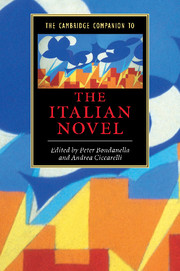Book contents
- Frontmatter
- 1 The belated development of a theory of the novel in Italian literary culture
- 2 The forms of long prose fiction in late medieval and early modern Italian literature
- 3 Alessandro Manzoni and developments in the historical novel
- 4 Literary realism in Italy
- 5 Popular fiction between Italian Unification and World War I
- 6 The foundations of Italian modernism
- 7 Neorealist narrative
- 8 Memory and testimony in Primo Levi and Giorgio Bassani
- 9 The Italian novel in search of identity
- 10 Feminist writing in the twentieth century
- 11 Italo Calvino and Umberto Eco
- 12 Literary cineastes
- 13 Frontier, exile, and migration in the contemporary Italian novel
- 14 The new Italian novel
- Index
- Series List
8 - Memory and testimony in Primo Levi and Giorgio Bassani
Published online by Cambridge University Press: 28 May 2006
- Frontmatter
- 1 The belated development of a theory of the novel in Italian literary culture
- 2 The forms of long prose fiction in late medieval and early modern Italian literature
- 3 Alessandro Manzoni and developments in the historical novel
- 4 Literary realism in Italy
- 5 Popular fiction between Italian Unification and World War I
- 6 The foundations of Italian modernism
- 7 Neorealist narrative
- 8 Memory and testimony in Primo Levi and Giorgio Bassani
- 9 The Italian novel in search of identity
- 10 Feminist writing in the twentieth century
- 11 Italo Calvino and Umberto Eco
- 12 Literary cineastes
- 13 Frontier, exile, and migration in the contemporary Italian novel
- 14 The new Italian novel
- Index
- Series List
Summary
In the works of Primo Levi and Giorgio Bassani, Italy has made a lasting contribution to Holocaust literature. This is a mode of writing that has few of the characteristic features of a literary genre. A term that came into use in the 1960s, Holocaust literature includes a wide and varied range of texts, from the diaries of the victims of the Holocaust, to the memoirs of the survivors, to the fiction of writers who have taken the Holocaust as the subject of their works. The characteristic feature of Holocaust literature is the commitment to preserve the memory of the offense and the memory of the victims. Those who survived the atrocity and took up their pens to bear witness are generally recognized as the great Holocaust writers. These include Elie Wiesel, Paul Celan, Tadeusz Borowski, and Primo Levi. Of all these Holocaust writers, the Italian Jewish writer Primo Levi occupies a special place. Imprisoned in Auschwitz for eighteen months, from the summer of 1943 until the end of the war, Levi was one of the very few Italian survivors of the concentration camp. His first book, written only two months after his return from the concentration camp – Se questo è un uomo – is widely recognized as one of the most lucid and dispassionate accounts of the lager, the German term for the death camps.
- Type
- Chapter
- Information
- The Cambridge Companion to the Italian Novel , pp. 125 - 135Publisher: Cambridge University PressPrint publication year: 2003



